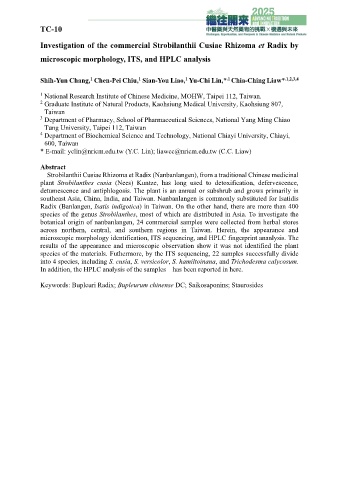Page 325 - 2025中醫藥與天然藥物聯合學術研討會-中醫藥與天然藥物的挑戰X機遇與未來大會手冊
P. 325
TC-10
Investigation of the commercial Strobilanthii Cusiae Rhizoma et Radix by
microscopic morphology, ITS, and HPLC analysis
,1
1
1
Shih-Yun Chang, Chen-Pei Chiu, Sian-You Liao, Y u -Chi Lin,* Chia-Ching Liaw* ,1,2,3,4
1
1 National Research Institute of Chinese Medicine, MOHW, Taipei 112, Taiwan.
2 Graduate Institute of Natural Products, Kaohsiung Medical University, Kaohsiung 807,
Taiwan
3 Department of Pharmacy, School of Pharmaceutical Sciences, National Yang Ming Chiao
Tung University, Taipei 112, Taiwan
4 Department of Biochemical Science and Technology, National Chiayi University, Chiayi,
600, Taiwan
* E-mail: yclin@nricm.edu.tw (Y.C. Lin); liawcc@nricm.edu.tw (C.C. Liaw)
Abstract
Strobilanthii Cusiae Rhizoma et Radix (Nanbanlangen), from a traditional Chinese medicinal
plant Strobilanthes cusia (Nees) Kuntze, has long used to detoxification, defervescence,
detumescence and antiphlogosis. The plant is an annual or subshrub and grows primarily in
southeast Asia, China, India, and Taiwan. Nanbanlangen is commonly substituted for Isatidis
Radix (Banlangen, Isatis indigotica) in Taiwan. On the other hand, there are more than 400
species of the genus Strobilanthes, most of which are distributed in Asia. To investigate the
botanical origin of nanbanlangen, 24 commercial samples were collected from herbal stores
across northern, central, and southern regions in Taiwan. Herein, the appearance and
microscopic morphology identification, ITS sequencing, and HPLC fingerprint ananlysis. The
results of the appearance and microscopic observation show it was not identified the plant
species of the materials. Futhermore, by the ITS sequencing, 22 samples successfully divide
into 4 species, including S. cusia, S. versicolor, S. hamiltoinana, and Trichodesma calycosum.
In addition, the HPLC analysis of the samples has been reported in here.
Keywords: Bupleuri Radix; Bupleurum chinense DC; Saikosaponins; Staurosides

